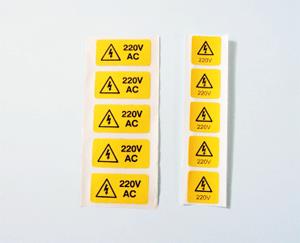What is 220V and where is it used?
02 November 2017
220V is a particular level of electrical potential from a power source, or in simpler terms, the strength of the push given to make electrons flow through an electrical cable.
 220V is the standard household voltage in dozens of countries, including China, Saudi Arabia, Chile, Egypt, the U.A.E, and South Korea. This is then used to power typical household appliances, such as TVs, fridges, and microwaves.
220V is the standard household voltage in dozens of countries, including China, Saudi Arabia, Chile, Egypt, the U.A.E, and South Korea. This is then used to power typical household appliances, such as TVs, fridges, and microwaves.In many countries there is a legal requirement to mark the voltage with a 220V warning label. View our 220V warning sign However, despite the warnings, it is unlikely that 220V would kill an otherwise healthy person; the individual would only experience a painful shock. It would however pose more serious danger to individuals with underlying heart conditions and other health issues.
Why use 220V over other voltages?
Many countries use lower voltages such as 110V or 120V. Although lower voltages are safer than higher voltages, higher voltages allow for thinner electrical cables whilst achieving the same level of electrical current.
Full list of countries that use 220V
Afghanistan, Angola, Argentina, Azerbaijan, Bangladesh, Benin, Brazil*, Burkina Faso, Burundi, Cameroon, Central Africa, Chad, Chile, China, Comoros, Congo, Ivory Coast, Djibouti, East Timor, Egypt, Equatorial Guinea, Ethiopia, French Guiana, Gabon, Guinea, Guinea-Bissau, Hong Kong, Kazakhstan, South Korea, Kyrgyzstan, Lesotho, Macau, Madagascar*, Mali, Martinique, Mauritania, Morocco, Mozambique, Namibia, New Caledonia, Niger, Paraguay, Peru, Philippines, Saudi Arabia*, Somalia, Syria, Tahiti, Tajikistan, Thailand, Togo, Turkmenistan, United Arab Emirates, Uruguay, Uzbekistan, Vietnam, Zimbabwe.
*Country uses more than one voltage.
To discuss your label needs contact us by e-mailsales@labelsource.co.uk or call us on 0800 3761693 (Freephone in the UK), or + 44 (0) 1443 842769 (outside UK).
Other Press Releases By This Company
- 08/09/2021 - Natasha’s Law – Are you ready?
- 10/01/2020 - Label Source Officially Joins The British Safety Industry Federation
- 09/08/2019 - What Are Dangerous Goods and How to Properly Label Them
- 09/08/2019 - Beneficial and Modern Uses of Asset Tagging and Management
- 09/08/2019 - Breathing Space: What is Local Exhaust Ventilation and Why Is It Important?
- 03/11/2017 - What Is An Entrapment Hazard?
- 03/11/2017 - Workplace Safety Posters: Which Ones Do you need?
- 02/11/2017 - Sharps Hazard & Sharp Object Signs & Labels
- 19/10/2016 - Signs for COMAH Regulation sites
- 19/10/2016 - Salmonella outbreak caused by cross contamination from kitchen utensils
- 12/10/2016 - Labels for enclosures and cabinets
- 05/10/2016 - Biogas Generation Equipment Marking.
- 05/10/2016 - PAT test stickers
- 27/09/2016 - CE product marking
- 27/09/2016 - QR barcode labels
- 30/03/2016 - Dangers of not displaying electrical warning signs.
- 30/03/2016 - Bespoke plastic nameplates.
- 05/03/2015 - QC labelling for your products
- 05/03/2015 - Inspection labels revised
- 05/03/2015 - Keep the workplace safe from electrical accidents
- 27/02/2015 - Personal protection at work
- 27/02/2015 - Industrial Equipment Safety Marking from Label Source
- 04/12/2014 - Valve tags for marking and identification
- 04/12/2014 - What is underground warning tape?
- 04/12/2014 - Safe use of gas cylinders
- 04/12/2014 - All the information you need to know about WEEE labels
- 04/12/2014 - Are you using CE labels correctly?
- 04/12/2014 - CE Legislation- for your understanding
- 05/11/2014 - Quality Control Labels
- 05/11/2014 - Stainless steel tags
- 05/11/2014 - Blank Metal nameplates for your requirements
- 05/11/2014 - Seriously Super Serial Number Labels
- 05/11/2014 - Inspection Labels- For your visual aid
- 05/11/2014 - Your 3 way step to Write and Seal Labels
- 20/10/2014 - Wide range of warehouse labels
- 20/10/2014 - Top-Quality Racking labels
- 20/10/2014 - Help your company become greener
- 20/10/2014 - Become green with Label Source
- 10/10/2014 - Why Electrical Labels are essential
- 10/10/2014 - Water Safety Signs: Making sure your water experience is safe!
- 10/10/2014 - Thermal Transfer Printing
- 10/10/2014 - Dangers in and around high voltage electricity
- 10/10/2014 - Safe and secure handling of hazardous waste
- 10/10/2014 - Prevent your workers from Needle Stick injuries
- 10/10/2014 - Prevent flu this winter by displaying your hygiene signs
- 10/10/2014 - Plastic tags to your own design
- 10/10/2014 - Laser Labels from Label Source
- 10/10/2014 - Quality Assurance labels for manufacturing use
- 10/10/2014 - Label Source guide to printing labels
- 10/10/2014 - Hazard warning labels fit for purpose
- 10/10/2014 - Focus on Site Security Signs
- 10/10/2014 - Businesses will pay for health and Safety Breaches
- 10/10/2014 - Barrier tapes for a safe environment
- 10/10/2014 - Are you at risk of Hand and Arm Vibration Syndrome?
- 09/10/2014 - 5 Safety Signs every workplace needs
- 13/01/2014 - Payments outside the UK
- 13/01/2014 - Label Source on the move
- 18/03/2009 - Label Source labelling the Health Service




